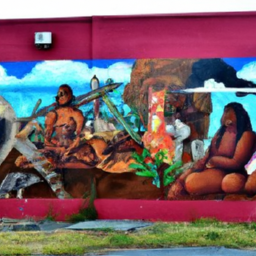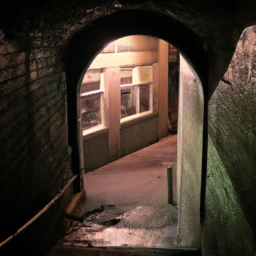
Unveiling the Urban Canvas: Exploring the Story and Influence of Local Street Art
Step into the vibrant world of local street art and uncover the fascinating story that unfolds on the urban canvas. Discover the captivating tales that lie behind each stroke of paint and the extraordinary influence these artworks have on the city’s culture. From hidden alleyways to bustling main streets, delve into the rich tapestry of colors and creativity that adorns the walls, guiding you through the heart and soul of the community. Immerse yourself in an enchanting journey, where the streets become an open-air gallery, showcasing the true essence of artistic expression.
Table of Contents
ToggleThe Emergence of Street Art
Street art, once considered an act of vandalism, has emerged as a powerful form of artistic expression that resonates with communities around the world. It has its roots in the early forms of urban graffiti, which began appearing on the walls of cities in the late 1960s and early 1970s. These early manifestations of street art were often simple tags or signatures, used by artists to mark their presence in public spaces.
Early Forms of Street Art
The early forms of street art were primarily influenced by the hip-hop and punk subcultures, with artists using spray paint and markers to create their work. One of the pioneers of this movement was the artist known as Cornbread, who began tagging walls in Philadelphia in the late 1960s. Other early street artists, such as Taki 183 in New York City and Blek le Rat in Paris, also played a significant role in shaping the trajectory of street art.
Evolution of Street Art
Over the years, street art has evolved from simple tags to a diverse range of artistic styles and techniques. Artists began to experiment with stencils, stickers, wheatpasting, and even installations. This expansion of techniques allowed for more intricate and thought-provoking artwork to be created. Artists like Banksy, Shepard Fairey, and Invader gained international recognition for their innovative approaches to street art.
The Role of Graffiti in Street Art
Graffiti, often seen as a controversial aspect of street art, has played a pivotal role in shaping the movement. It has been both a point of contention and a source of inspiration for street artists. While some view graffiti as an act of vandalism, others see it as a form of creative expression that pushes the boundaries of traditional art. Graffiti has influenced the styles and techniques used by street artists and continues to be an integral part of the street art culture.
The Cultural Significance of Local Street Art
Street art serves as a visual representation of the identity and culture of a community. It reflects the local narratives and histories that might otherwise go unnoticed.
Expression of Identity and Local Culture
Local street art provides a platform for artists to express their identity, reflecting the unique experiences and perspectives of the local community. From murals depicting local heroes or historical events to artwork that explores personal struggles and triumphs, street artists bring to life the stories that shape a community’s culture.
Response to Social and Political Issues
Street art has become an important tool for social and political commentary. Local artists use their work to address pressing issues, such as inequality, discrimination, and environmental concerns. Through eye-catching and thought-provoking pieces, street art serves as a catalyst for conversations and encourages viewers to question the status quo.
Establishing a Sense of Place
Local street art contributes to the creation of an urban aesthetic that sets a neighborhood or city apart. The presence of vibrant and engaging artwork can transform a mundane street into a destination. Street art becomes an integral part of a community’s character, attracting visitors and fostering a sense of pride among residents.
Influence on Urban Aesthetics
Street art has the power to transform neglected spaces into vibrant urban landscapes. Its influence goes beyond aesthetics and plays a crucial role in revitalizing neighborhoods.
Transforming Derelict Spaces
Street artists often target neglected walls, buildings, and public spaces as their canvas. By transforming derelict spaces with their artwork, they give these areas a new lease on life. Former eyesores become focal points of beauty and creativity, breathing new life into previously forgotten corners of the city.
Artistic Revitalization of Neighborhoods
The presence of street art can have a profound impact on the socioeconomic dynamics of a neighborhood. As artists and enthusiasts flock to an area to witness the vibrant street art scene, local businesses thrive. Art galleries, cafes, and independent shops emerge, creating a vibrant cultural hub that attracts both locals and tourists.
Integration of Street Art in Urban Planning
Forward-thinking cities have started incorporating street art into urban planning. Public art initiatives, such as designated street art districts or community-led murals, have become integral parts of urban revitalization strategies. This integration allows for a balanced coexistence of creativity and built environment, contributing to the overall aesthetic and cultural fabric of the city.
Street Art and Tourism
Street art has become a significant draw for tourists, attracting visitors from around the world who are eager to explore the vibrant and dynamic art scene of a city.
Attraction of Street Art Tours
Street art tours have gained popularity as a way for visitors to immerse themselves in the local art scene. Guided tours lead participants through the streets, showcasing the best examples of street art and providing insight into the stories and techniques behind the artwork.
The Rise of Street Art Tourism
Street art tourism has become a niche market, with travelers seeking out cities and neighborhoods known for their thriving street art scenes. Destinations like Berlin, Melbourne, and New York City have capitalized on this trend by promoting their street art culture and hosting international street art festivals, attracting art enthusiasts from far and wide.
Economic Impact on Local Businesses
The influx of tourists to areas with vibrant street art scenes has a significant economic impact on local businesses. Street art hotspots often see an increase in foot traffic, leading to higher revenues for cafes, restaurants, and shops. Local entrepreneurs have recognized the potential of street art to drive economic growth and have leveraged this by opening businesses that cater specifically to street art enthusiasts.
Street Art and Community Engagement
Street art is not just a form of self-expression for artists; it also serves as a catalyst for community engagement and empowerment.
Promotion of Public Art Projects
Through public art projects, communities have the opportunity to actively participate in the creation of their urban environment. Street art serves as a platform for collaboration between artists and community members, fostering a sense of ownership and pride in the artistic endeavors.
Fostering Community Connections
Street art has the power to bring people together. It creates a shared experience and serves as a point of connection between residents and visitors. Local street art events and festivals provide opportunities for communities to gather, celebrate, and support the artists who contribute to their cultural landscape.
Engaging Youth and Empowering Artists
Street art offers an alternative creative outlet for young people who may not have access to traditional art education. It provides a medium through which they can express themselves, channel their energy, and develop their artistic skills. Moreover, street art empowers artists by giving them a platform to share their talents with a wider audience and break down barriers to traditional art spaces.
Legal and Ethical Considerations
The relationship between street art and legality remains a complex and often contentious issue. Questions surrounding ownership, property rights, and the distinction between vandalism and art continue to be debated.
Navigating the Boundaries of Public and Private Property
Street artists must tread carefully when it comes to determining where they can legally create their artwork. While public spaces are generally more accepting of street art, private property owners may view it as a trespass or act of vandalism. Artists often have to seek permission or collaborate with property owners to create street art legally.
The Debate on Vandalism or Art
Street art blurs the lines between vandalism and art, challenging traditional notions of what constitutes acceptable forms of artistic expression. While some argue that unauthorized street art defaces public spaces, others argue that it adds cultural value and should be protected as a form of public art.
Balancing Creative Freedom and Respect for Space
Street artists face the challenge of balancing their desire for creative freedom with respect for the communities in which they work. Artists must be conscious of the impact their artwork may have on the neighborhood, ensuring that their creations are respectful and considerate of the local environment.
Preservation and Conservation
Street art’s ephemeral nature presents unique challenges when it comes to its preservation and conservation. Efforts are underway to document, conserve, and protect this ever-evolving art form.
Challenges of Preserving Street Art
The transient nature of street art poses significant challenges for its preservation. Factors such as weathering, vandalism, urban development, and the passage of time can deteriorate or destroy street art pieces. Preservation efforts must be proactive and agile to ensure the longevity of these artworks.
Efforts to Conserve Street Art
Many cities and organizations are recognizing the cultural value of street art and are taking steps to conserve it. Initiatives such as protective coatings, which can shield street art from elements, and the creation of dedicated street art museums or galleries allow for the preservation of these ephemeral artworks.
The Role of Technology in Documentation
Technology plays a crucial role in documenting and archiving street art. Websites, social media platforms, and digital databases have emerged as valuable tools for cataloging and sharing street art, ensuring that even if the physical artwork disappears, its legacy and impact continue to be felt.
Critiques and Controversies
Street art has not been without its fair share of critiques and controversies. Some argue that its increasing commercialization and the appropriation of urban art hinder the movement’s authenticity and integrity.
Commercialization and Co-optation of Street Art
The increasing popularity of street art has led to its commercialization, with the art market capitalizing on its appeal. Critics argue that this commercialization can dilute the original intent and spirit of street art, reducing it to a marketable commodity rather than a form of self-expression.
Gentrification and the Appropriation of Urban Art
The appropriation of street art by gentrifying forces has also sparked controversy. In some cases, street art has been used as a tool to attract affluent residents and investors, ultimately leading to the displacement of low-income communities and artists who were at the forefront of the street art movement.
Controversial Messages and Public Perception
Street art, particularly pieces that tackle sensitive social and political issues, can be met with public resistance or controversy. Artworks with controversial messages may spark debates and divide public opinion. Street artists must navigate the fine line between self-expression and public reception, considering the impact their artwork may have on the community.
The Future of Local Street Art
As local street art continues to evolve and adapt, its future remains promising and dynamic. Several key trends and developments point to its sustained growth and impact.
Sustainable Models of Street Art
The future of street art lies in sustainability and community engagement. Collaborative projects that involve artists, community members, and local organizations can ensure the ongoing creation and preservation of meaningful street art that reflects the evolving needs and aspirations of the community.
Dynamic Interplay with Technology
Technology will play an increasingly vital role in the future of street art. Advancements such as augmented reality, interactive installations, and digital mapping are likely to transform the way we experience and interact with street art. This interplay between art and technology will open up new possibilities for creativity and audience engagement.
Empowering Local Artists for Social Change
As street art continues to gain recognition as a powerful tool for social and political commentary, local artists have the potential to drive meaningful change within their communities. By amplifying their voices and harnessing the power of street art, artists can inspire dialogue, challenge societal norms, and advocate for a more inclusive and just society.
Conclusion
Local street art has emerged as a vibrant and influential force within cities around the world. From its humble beginnings as urban graffiti to its current status as a respected art form, street art has transformed neglected spaces, sparked cultural conversations, and empowered artists and communities alike. As it continues to evolve and adapt to the changing dynamics of urban landscapes, local street art promises to be an enduring and impactful part of our cultural fabric.
You May Also Like

How Vancouver Washington Got It’s Name
25 September 2023
Best Places To Eat In Vancouver Washington
4 August 2023


